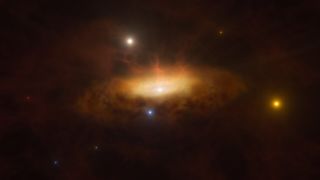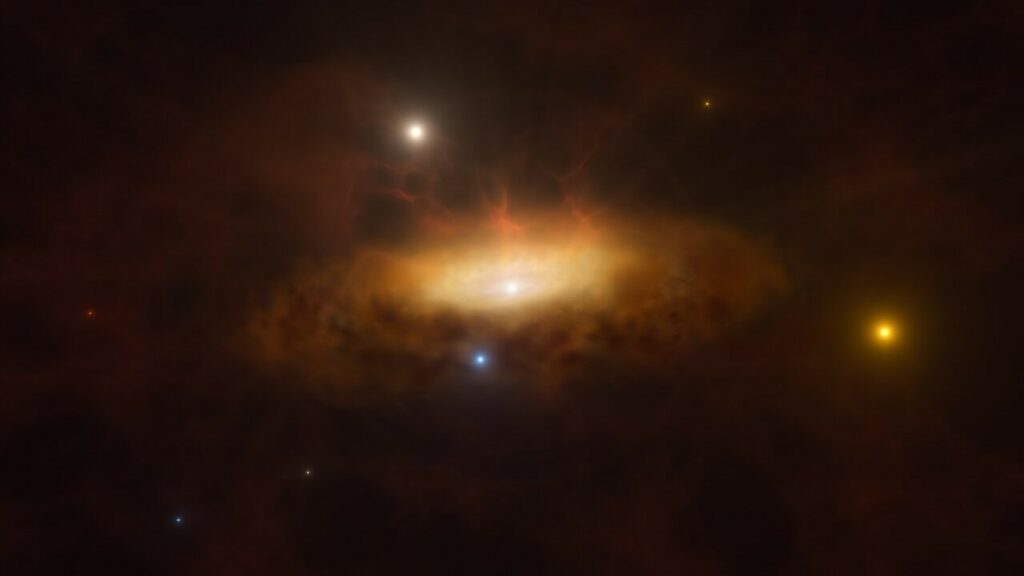
An illustration of the long-dormant black hole “waking up” as a glut of gas and dust pours into its maw.
(Image credit: ESO/M. Kornmesser)
For the first time ever, astronomers have witnessed the black hole at the center of a galaxy roaring to life in real time — and they’re not sure why it happened.
The awakening of the cosmic monster, which is a million times the mass of our sun and located 300 million light-years away inside the galaxy SDSS1335+0728, is unlike anything astronomers have seen before.
Scientists were notified of the transformation when the Zwicky Transient Facility in California recorded a sudden leap in the galaxy’s brightness in 2019. Follow-up observations found that the galaxy had become four times brighter in ultraviolet frequencies and was spewing out 10 times more X-rays than before. And it’s still growing brighter four years later. The researchers will publish their findings in the journal Astronomy and Astrophysics.
“Imagine you’ve been observing a distant galaxy for years, and it always seemed calm and inactive,” study lead author Paula Sánchez Sáez, an astronomer at the European Southern Observatory in Germany, said in a statement. “Suddenly, its [core] starts showing dramatic changes in brightness, unlike any typical events we’ve seen before.”
Related: 1st detection of ‘hiccupping’ black hole leads to surprising discovery of 2nd black hole orbiting around it
Supermassive black holes lurk at the centers of most galaxies, including our own. Their immense gravity tethers dust, gas, stars and planets to a loose orbit around them. Light is incapable of escaping the powerful gravitational pull of a black hole, but that doesn’t mean it doesn’t produce any.
This is because superheated, glowing matter that’s been stripped from planets, stars, gas, dust and other black holes can swirl around the entrance to the monster’s jaws at close to the speed of light. Once the plasma plunges over the black hole’s precipice, or event horizon, it is lost inside forever.
Get the world’s most fascinating discoveries delivered straight to your inbox.
Scientists aren’t sure what caused the sudden brightening, but they suggest it’s most likely the result of a feeding frenzy of some kind — whereupon new material rapidly heats up as it falls into the black hole’s clutches.
“In the case of SDSS1335+0728, we were able to observe the awakening of the massive black hole, [which] suddenly started to feast on gas available in its surroundings, becoming very bright,” study co-author Claudio Ricci, an astronomer at Diego Portales University in Chile, said in the statement.
Another hypothesis is that astronomers are witnessing a tidal disruption event — where a star or blob of matter produces a flare as it’s stretched and ripped apart by a black hole’s gravity. However, such events are normally much shorter in duration, lasting a few hundred days at most rather than several years.
The astronomers will now make further observations to search for the cause of the sudden wake-up.
“Regardless of the nature of the variations, [this galaxy] provides valuable information on how black holes grow and evolve,” Sánchez Sáez said. Observations with cutting-edge instruments, like those on the Extremely Large Telescope (ELT), currently under construction in Chile, should provide more insights.
Ben Turner is a U.K. based staff writer at Live Science. He covers physics and astronomy, among other topics like tech and climate change. He graduated from University College London with a degree in particle physics before training as a journalist. When he’s not writing, Ben enjoys reading literature, playing the guitar and embarrassing himself with chess.
>>> Read full article>>>
Copyright for syndicated content belongs to the linked Source : Live Science – https://www.livescience.com/space/black-holes/supermassive-black-hole-roars-to-life-before-astronomers-eyes-in-world-1st-observations
